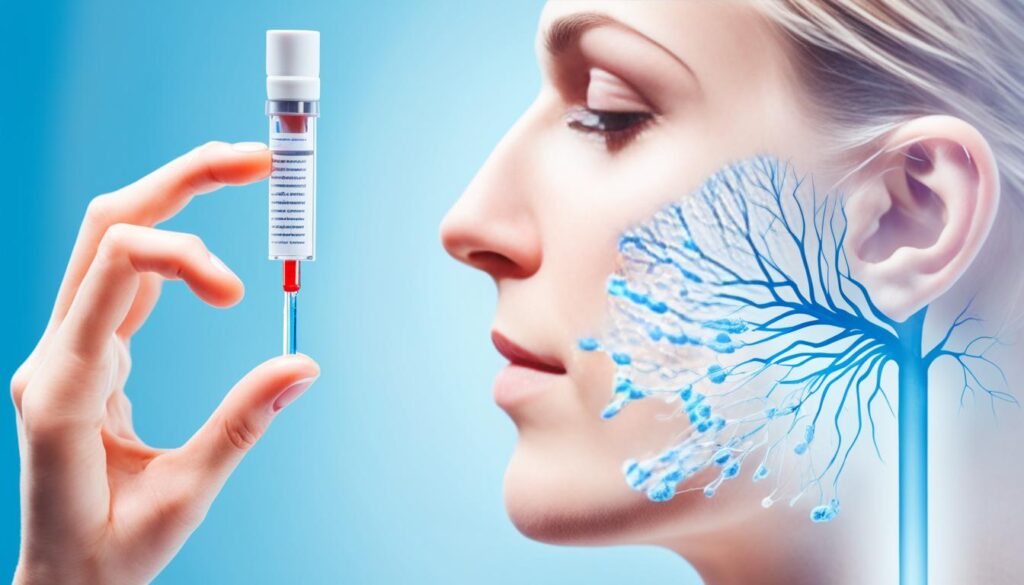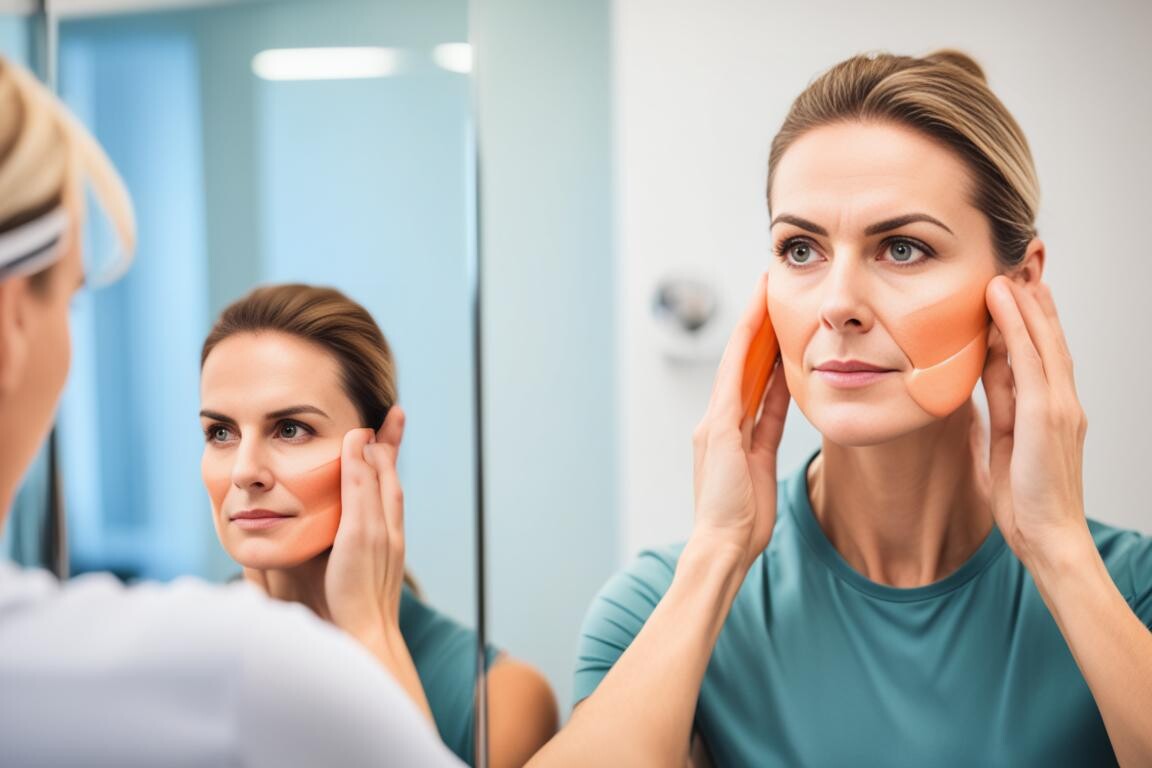Facial paralysis can have a significant impact on your life, affecting your ability to communicate, express emotions, and perform daily activities. However, there are effective treatment options available in India to restore symmetry and improve function for individuals with facial paralysis. Whether the paralysis is caused by a stroke, brain tumor, or Bell’s palsy, various therapies can help you regain control of your facial muscles and enhance your quality of life.
Key Takeaways:
- Facial paralysis treatment in India offers effective therapies to restore facial symmetry and function.
- Treatment options may include medications, physical therapy, surgical interventions, and alternative treatments.
- Diagnosis of facial paralysis involves examining the face and performing tests to determine the underlying cause.
- Medications like corticosteroids and antiviral drugs can help reduce inflammation and manage symptoms.
- Physical therapy exercises can prevent muscle shrinkage and promote facial muscle strength and flexibility.
Table of Contents
ToggleDiagnosis of Facial Paralysis
Diagnosing facial paralysis involves examining the face and assessing your ability to move facial muscles. To determine the cause of your condition, healthcare providers may perform various tests to rule out other conditions that can cause facial muscle weakness.
- One common cause of facial paralysis is Bell’s palsy, which is a sudden weakness or paralysis of the muscles on one side of the face.
- Other potential causes of facial muscle weakness include strokes, infections, Lyme disease, or tumors.
Some of the tests that may be conducted to diagnose facial paralysis include:
- Electromyography (EMG): This test measures the electrical activity in your facial muscles and can help determine the extent of muscle weakness.
- Imaging scans: MRI or CT scans may be done to examine the structures in your face and rule out any underlying conditions.
- Blood tests: These tests can help identify any infections or autoimmune conditions that may be causing facial muscle weakness.
Once your healthcare provider has determined the cause of your facial paralysis, they can recommend appropriate treatment options to restore symmetry and improve function.
Treatment Options for Facial Paralysis
The treatment for facial paralysis depends on the underlying cause and the duration of the condition. Here are some common treatment options:
- Medications: Certain medications can help reduce inflammation and manage symptoms associated with facial paralysis. This may include:
| Medications | Purpose |
|---|---|
| Corticosteroids | Reduce inflammation and swelling of the facial nerve |
| Antiviral drugs | Manage symptoms and speed up recovery in cases of viral causes, such as Bell’s palsy |
- Physical therapy: Engaging in physical therapy exercises can help prevent muscle shrinkage and promote recovery. These exercises are designed to improve muscle strength, flexibility, and overall facial movement. They may include:
- Facial massage techniques
- Stretching exercises for facial muscles
- Mirror exercises to facilitate muscle coordination
- Surgery: In some cases, surgery may be required for facial reanimation and restoration of symmetry. Surgical options for facial paralysis may include:
| Surgical Procedures | Description |
|---|---|
| Nerve decompression | Relieves pressure on the facial nerve, allowing for improved function |
| Nerve repair | Reconnects damaged or severed nerves to restore facial movement |
| Temporalis tendon transfer | Utilizes a tendon from the temple region to provide movement to the affected side of the face |
| Gracilis muscle transplant | Transplants a muscle from the inner thigh to replace paralyzed facial muscles |
- Eye protection: Protecting the affected eye is crucial in cases of facial paralysis. This helps prevent dryness, corneal injury, and other eye-related complications. Eye protection measures may include:
- Lubricating eye drops to keep the eye moist
- Eye patches to protect the eye during sleep or periods of reduced blink reflex
- Glasses or goggles to shield the eye from debris and environmental factors
It’s important to consult with a healthcare professional to determine the most suitable treatment options for your specific condition. They can evaluate the underlying cause, severity, and other individual factors to create a personalized treatment plan.

Medications for Facial Paralysis
When it comes to treating facial paralysis, medications play a crucial role in reducing inflammation, managing symptoms, and promoting recovery. Two commonly prescribed types of medications for facial paralysis are corticosteroids and antiviral drugs.
Corticosteroids
Corticosteroids such as prednisone are often prescribed to reduce inflammation and swelling of the facial nerve. They work by suppressing the immune response that may be causing the paralysis. By reducing inflammation, corticosteroids help alleviate symptoms and improve facial movement.
Antiviral Drugs
In cases of severe facial paralysis, antiviral drugs may be prescribed in combination with corticosteroids. These medications are primarily used to treat Bell’s palsy, a common cause of facial paralysis. Antiviral drugs, such as valacyclovir and acyclovir, target viral infections that may contribute to the development of facial paralysis. They can help reduce viral replication and speed up the recovery process.
It’s important to note that the effectiveness of antiviral drugs alone in treating facial paralysis is still a subject of debate among medical professionals. However, when used in combination with corticosteroids, they may provide additional benefits in certain cases.
If you believe medications may be a suitable treatment option for your facial paralysis, consult with a healthcare provider who can assess your condition and determine the most appropriate course of treatment.

| Medication | Usage | Potential Side Effects |
|---|---|---|
| Prednisone (corticosteroid) | Reduces inflammation of the facial nerve | – Increased appetite – Weight gain – Mood changes |
| Valacyclovir (antiviral drug) | Treats viral infections associated with facial paralysis | – Headache – Nausea – Vomiting |
| Acyclovir (antiviral drug) | Treats viral infections associated with facial paralysis | – Diarrhea – Fatigue – Skin rash |
Physical Therapy for Facial Paralysis
Physical therapy is an essential component of the treatment plan for facial paralysis. Working with a skilled physical therapist can help you regain facial movement and promote muscle strength and flexibility. Through targeted exercises and specialized techniques, physical therapy can prevent muscle shrinkage and improve facial symmetry.
The exercises prescribed by a physical therapist are designed to stimulate and activate the facial muscles, promoting blood flow and encouraging muscle recovery. Alongside exercises, massage techniques may also be used to enhance circulation, relax muscle tension, and improve overall facial function.
Regular physical therapy sessions can provide you with the guidance and support needed to regain control over your facial muscles. The therapist will create a tailored program based on your specific needs and goals. By following the recommended exercises and techniques, you can gradually improve your facial movement and restore symmetry.
Benefits of Physical Therapy for Facial Paralysis
- Improves muscle strength and control in the affected areas
- Enhances blood flow and promotes healing
- Prevents muscle shrinkage and stiffness
- Aids in the restoration of facial symmetry
- Boosts confidence and self-esteem

| Physical Therapy Techniques for Facial Paralysis | Benefits |
|---|---|
| Facial exercises | Stimulates muscle activity and improves muscle tone |
| Massage techniques | Enhances blood flow, relaxes muscles, and reduces muscle tension |
| Stretching exercises | Improves flexibility and range of motion in the facial muscles |
| Resistance training | Strengthens facial muscles and promotes muscle control |
| Neuromuscular reeducation | Helps re-establish the connection between the nerves and muscles |
Consistency and commitment to the physical therapy regimen are vital for optimal results. It’s important to follow your therapist’s instructions and practice the exercises regularly at home. Over time, you can expect to see improvements in your facial movement, muscle strength, and overall facial symmetry.
Surgical Options for Facial Paralysis
In cases of chronic facial paralysis, surgical interventions may be necessary to restore facial movement. Surgical procedures, such as facial reanimation, can help improve facial symmetry and function. The choice of surgery depends on the severity and duration of the paralysis, as well as the individual’s specific needs and goals.
One common surgical option for facial paralysis is decompression surgery. This procedure involves relieving pressure on the facial nerve, which can help restore facial movement. By removing any compressive factors, such as bone or scar tissue, decompression surgery aims to alleviate nerve dysfunction and promote nerve regeneration.
Nerve transfer is another surgical technique used to treat facial paralysis. In this procedure, healthy nerves from other parts of the body, such as the leg or arm, are surgically connected to the paralyzed facial muscles. This allows for the transfer of nerve signals and facilitates muscle movement, leading to improved facial symmetry and expression.
Muscle transfer is also a surgical option for facial reanimation. During muscle transfer surgery, healthy muscles from other parts of the body, such as the thigh or abdomen, are transplanted to replace the paralyzed facial muscles. These transferred muscles can then be connected to the facial nerve, allowing for restored facial movement and improved facial symmetry.

It’s important to note that the choice of surgical procedure depends on the individual’s specific condition and goals, as well as the surgeon’s expertise and recommendations. A thorough evaluation and consultation with a facial paralysis specialist will help determine the most suitable surgical approach.
| Surgical Options | Description |
|---|---|
| Decompression surgery | Relieves pressure on the facial nerve to restore facial movement |
| Nerve transfer | Connects healthy nerves from other parts of the body to paralyzed facial muscles for improved movement |
| Muscle transfer | Transplants healthy muscles from other parts of the body to replace paralyzed facial muscles and restore movement |
Alternative Treatments for Facial Paralysis
Although there is limited scientific evidence, some alternative treatments may provide relief for facial paralysis. These alternative therapies focus on stimulating nerves, improving muscle function, and managing symptoms associated with facial paralysis. While their effectiveness may vary for each individual, they offer potential options for those seeking alternative approaches.
1. Acupuncture
Acupuncture is an ancient Chinese practice that involves inserting thin needles into specific points on the body. It is believed to stimulate nerves and muscles, potentially improving facial function in individuals with facial paralysis. While the exact mechanism is still not fully understood, some studies suggest that acupuncture may help promote nerve regeneration and reduce inflammation. However, more research is needed to determine its efficacy for facial paralysis treatment.
2. Biofeedback Training
Biofeedback training is a mind-body technique that helps individuals gain better control over their facial muscles. During biofeedback sessions, sensors are placed on the face to measure muscle activity. By receiving real-time feedback about their muscle movements, individuals can learn to control and modify their facial expressions. This technique aims to retrain the muscles and improve their coordination, potentially enhancing facial symmetry and function.
3. Botulinum Toxin Injections
Botulinum toxin, commonly known as Botox, is a neurotoxic protein that can be used to manage certain symptoms associated with facial paralysis. When injected into specific facial muscles, it temporarily paralyzes them, reducing involuntary movements such as facial spasms. Botulinum toxin injections can help improve facial symmetry and reduce the severity of abnormal muscle contractions caused by facial paralysis. However, it is important to note that the effects are temporary, and repeat injections may be necessary.
While alternative treatments like acupuncture, biofeedback training, and botulinum toxin injections may offer potential benefits for individuals with facial paralysis, it is essential to consult with a healthcare professional before pursuing any alternative therapy. A healthcare provider can assess your specific condition, provide personalized recommendations, and ensure that these treatments are safe and suitable for you.

Preparing for Facial Paralysis Treatment Appointment
When preparing for your facial paralysis treatment appointment, it’s important to take certain steps to ensure a productive and informative visit. By being well-prepared, you can make the most of your time with the healthcare provider and get the answers you need. Here are some essential tips to help you get ready:
- Describe your symptoms: Be ready to provide a detailed description of your facial paralysis symptoms, including when they started, their severity, and any changes you’ve noticed. It’s important to mention any recent stresses or life changes that may have contributed to the condition.
- Provide medication information: Make sure to bring a list of all the medications, vitamins, and supplements you are currently taking. This will help your healthcare provider assess any potential interactions or side effects that may impact your treatment.
- Bring a companion: Consider having a family member or friend accompany you to the appointment. They can help remember important information discussed during the visit and offer support during the treatment journey.
- Prepare a list of questions: Jot down a list of questions you would like to ask your healthcare provider regarding your facial paralysis treatment. This will ensure that you cover all your concerns and receive the necessary information to make informed decisions about your care.
By following these steps, you can actively participate in your facial paralysis treatment journey and optimize the outcomes of your appointment. Remember, open communication and collaboration with your healthcare provider are key to achieving the best possible results.

The Importance of Preparation for Your Facial Paralysis Treatment Appointment
Preparing for your facial paralysis treatment appointment plays a crucial role in ensuring that you receive the most effective care. By describing your symptoms, providing medication information, bringing a companion, and preparing questions, you empower yourself to actively engage in the treatment process. Effective communication and thorough preparation lay the foundation for a successful treatment plan and maximize your chances of achieving optimal results.
Surgical Procedures for Facial Paralysis Recovery
Surgical procedures play a vital role in the recovery of facial paralysis. When conservative treatments fail to restore facial movement and symmetry, surgical interventions offer hope for patients seeking to regain facial function. In this section, we will explore various surgical procedures that can help address both acute and chronic facial paralysis.
Nerve Decompression and Repair
Nerve decompression and repair procedures are effective options for acute facial paralysis, such as Bell’s palsy. These surgeries involve relieving pressure on the facial nerve to restore its function. During the procedure, a surgeon carefully identifies and removes any compressive tissues or structures that may be impeding the nerve’s function. Repairing and reconnecting damaged nerve fibers may also be necessary to facilitate nerve regeneration and improve facial movement.
Temporalis Tendon Transfer
For chronic facial paralysis cases, where the facial muscles have atrophied or been irreversibly damaged, temporalis tendon transfer is a surgical option that can help restore facial movement. This procedure involves using a small portion of the temporalis muscle, a muscle responsible for chewing, and transferring it to the paralyzed side of the face. By connecting the transferred muscle to the corner of the mouth, it can mimic natural muscle movement, allowing the patient to smile.
Gracilis Muscle Transplant
In situations where the facial paralysis involves the loss of a larger portion of the facial muscles, a gracilis muscle transplant may be recommended. This surgical procedure utilizes the gracilis muscle, typically from the inner thigh, to replace the damaged facial muscles. The gracilis muscle is carefully transplanted to the face and connected to the nerve supply. Over time, this muscle can regain its strength and coordination, providing improved facial movement and symmetry.
These surgical procedures offer hope and improved outcomes for individuals with facial paralysis. It is crucial to consult with a qualified surgeon who specializes in facial reanimation to determine the most suitable surgical approach based on the individual’s specific condition and desired outcomes.
Conclusion
Facial paralysis can have a profound impact on your quality of life, affecting your ability to communicate and express emotions. Fortunately, a wide range of effective treatment options are available in India to address facial paralysis and restore facial symmetry and function. By working closely with healthcare providers and exploring various treatment approaches, you can find the most suitable therapy for your individual condition.
From medications and physical therapy to surgical interventions, there are several avenues to pursue in your journey towards facial reanimation and improved facial movements. Medications such as corticosteroids and antiviral drugs can help reduce inflammation and manage symptoms. Physical therapy exercises play a crucial role in preventing muscle shrinkage and promoting recovery, while surgical procedures like facial nerve decompression and muscle transfers can restore facial movement and symmetry.
Remember that every individual’s experience with facial paralysis is unique. Your healthcare provider will evaluate your specific condition and develop a personalized treatment plan tailored to your needs. Be proactive and ask questions during your appointments to ensure you have a thorough understanding of your treatment options and what to expect.
With effective therapies available, there is hope for those affected by facial paralysis to regain their confidence and facial functionality. By committing to your treatment plan and staying optimistic, you can overcome the challenges brought by facial paralysis and regain control of your life.
FAQ
What are the treatment options for facial paralysis?
Treatment options for facial paralysis depend on the underlying cause and duration of the condition. They may include medications, physical therapy, surgery, and eye protection.
What medications are commonly used to treat facial paralysis?
Corticosteroids such as prednisone are commonly used to reduce inflammation and swelling of the facial nerve. Antiviral drugs like valacyclovir and acyclovir may be prescribed in combination with corticosteroids for severe cases of Bell’s palsy.
How does physical therapy help in the treatment of facial paralysis?
Physical therapy plays a crucial role in the treatment of facial paralysis. It can teach patients specific exercises and techniques to massage and exercise the facial muscles, prevent muscle shrinkage, and promote muscle strength and flexibility, improving facial movement and symmetry.
Are there any surgical options for facial paralysis?
Yes, in cases of chronic facial paralysis, surgical interventions may be necessary to restore facial movement. Facial reanimation surgeries can involve decompression of the facial nerve, nerve transfers from other parts of the body, or muscle transfers to replace the paralyzed muscles.
What are some alternative treatments for facial paralysis?
Some alternative treatments that may provide relief for facial paralysis include acupuncture, biofeedback training, and botulinum toxin injections. Acupuncture is believed to stimulate nerves and muscles, potentially improving facial function. Biofeedback training helps patients gain better control over their facial muscles, and botulinum toxin injections can manage symptoms such as facial spasms and improve facial symmetry.
How should I prepare for a facial paralysis treatment appointment?
To prepare for a facial paralysis treatment appointment, describe your symptoms and any recent stresses or life changes to your healthcare provider. Bring a list of all medications, vitamins, and supplements you are taking. It’s helpful to have a family member or friend accompany you to remember information, and prepare a list of questions to ask your healthcare provider.
What surgical procedures are involved in facial paralysis recovery?
Surgical procedures such as nerve decompression, nerve repair, temporalis tendon transfer, and gracilis muscle transplant can be effective for facial paralysis recovery. These procedures involve using muscles and nerves from other parts of the body to restore facial movement and symmetry.
Source Links
About The Author

This article is medically reviewed by Dr. Chandril Chugh, Board-Certified Neurologist, providing expert insights and reliable health information.
Dr. Chandril Chugh is a U.S.-trained neurologist with over a decade of experience. Known for his compassionate care, he specializes in treating neurological conditions such as migraines, epilepsy, and Parkinson’s disease. Dr. Chugh is highly regarded for his patient-centered approach and dedication to providing personalized care.
→ Book a consultation to discover which remedies suit your needs best.




